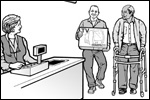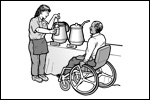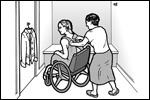



banner.jpg)

More information
Summary of Lesson One
Making it possible for customers with disabilities to purchase your goods and services is an important part of complying with the ADA.
The ADA requires businesses to make “reasonable modifications” in their normal ways of doing things when necessary to accommodate people who have disabilities.
Most accommodations involve making minor adjustments in procedures or providing some extra assistance. Usually the customer will let you know if he or she needs some kind of accommodation.
Businesses are not required to change their policies and procedures in any way that would cause a “fundamental alteration” in the nature of their goods or services, would undermine safe operation of the business, or would cause a “direct threat” to the health or safety of others.
As a rule, people with disabilities may not be excluded from services or isolated from other customers unless it is necessary for the safe operation of a business. If legitimate safety requirements make it necessary to exclude or isolate a person with a disability, they must be based on actual risks and not on stereotypes or generalizations about people with disabilities.
Businesses must allow people with disabilities to bring their service animals into all areas of the business where customers are normally allowed to go.
Questions
1. In a business like yours, what are some of the ways that a customer with a disability may need extra assistance?
2. Do your employees know they are supposed to provide extra assistance to a customer with a disability when needed, as long as it does not jeopardize the safe operation of your business?
3. Have you ever had the experience of having a customer with a service animal?
4. Do your employees know that service animals are working animals, not pets, and are permitted wherever customers are permitted, as long as the animal is under control and does not present a direct threat to others?











